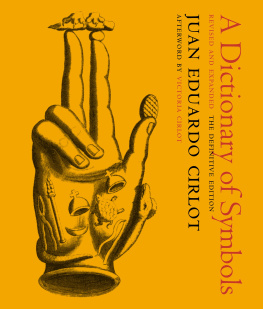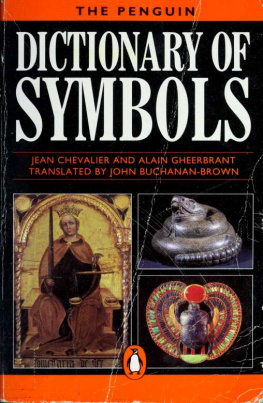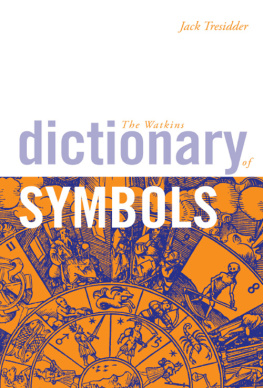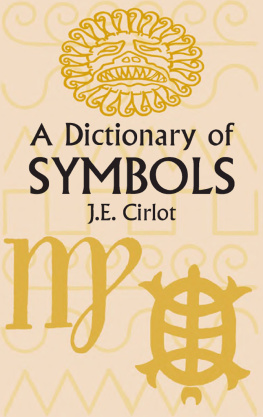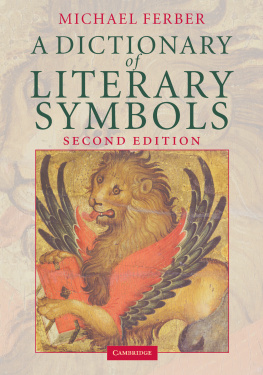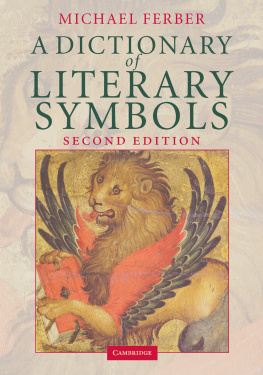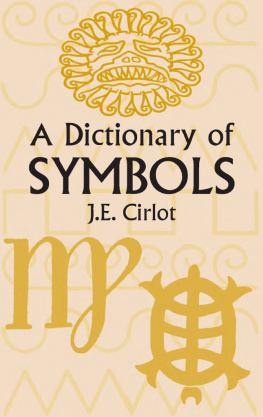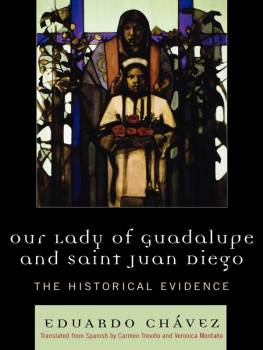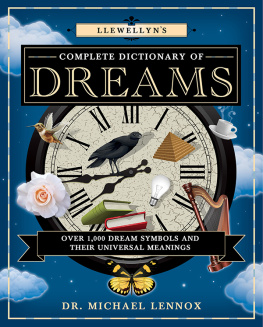Juan Eduardo Cirlot - A Dictionary of Symbols
Here you can read online Juan Eduardo Cirlot - A Dictionary of Symbols full text of the book (entire story) in english for free. Download pdf and epub, get meaning, cover and reviews about this ebook. year: 2020, publisher: New York Review Books, genre: Religion. Description of the work, (preface) as well as reviews are available. Best literature library LitArk.com created for fans of good reading and offers a wide selection of genres:
Romance novel
Science fiction
Adventure
Detective
Science
History
Home and family
Prose
Art
Politics
Computer
Non-fiction
Religion
Business
Children
Humor
Choose a favorite category and find really read worthwhile books. Enjoy immersion in the world of imagination, feel the emotions of the characters or learn something new for yourself, make an fascinating discovery.
- Book:A Dictionary of Symbols
- Author:
- Publisher:New York Review Books
- Genre:
- Year:2020
- Rating:3 / 5
- Favourites:Add to favourites
- Your mark:
- 60
- 1
- 2
- 3
- 4
- 5
A Dictionary of Symbols: summary, description and annotation
We offer to read an annotation, description, summary or preface (depends on what the author of the book "A Dictionary of Symbols" wrote himself). If you haven't found the necessary information about the book — write in the comments, we will try to find it.
A Dictionary of Symbols — read online for free the complete book (whole text) full work
Below is the text of the book, divided by pages. System saving the place of the last page read, allows you to conveniently read the book "A Dictionary of Symbols" online for free, without having to search again every time where you left off. Put a bookmark, and you can go to the page where you finished reading at any time.
Font size:
Interval:
Bookmark:

A DICTIONARY OF SYMBOLS
Revised and Expanded
JUAN EDUARDO CIRLOT
Translated from the Spanish by
JACK SAGE
and VALERIE MILES
Foreword by
HERBERT READ
Afterword by
VICTORIA CIRLOT
NEW YORK REVIEW BOOKS

New York
THIS IS A NEW YORK REVIEW BOOK
PUBLISHED BY THE NEW YORK REVIEW OF BOOKS
435 Hudson Street, New York, NY 10014
www.nyrb.com
Copyright 1969 by Victoria Cirlot Valenzuela and Lourdes Cirlot Valenzuela
Copyright 1997, 2011 by Ediciones Siruela, S.A.
Translations of first and second editions copyright 1962, 1971 by Victoria Cirlot Valenzuela and Lourdes Cirlot Valenzuela
Translation of material added for revised and expanded edition copyright 2020 by Valerie Miles
Afterword copyright 1997, 2020 by Victoria Cirlot Valenzuela All rights reserved.
First published in the Spanish language in 1958 by Editorial Luis Miracle, Barcelona, as Diccionario de smbolos tradicionales. Later published in Spanish in 1969 by Editorial Labor, Barcelona, under the title Diccionario de smbolos. Published in Spanish, with an afterword by Victoria Cirlot, in 1997 by Ediciones Siruela, Madrid. First published in the English language in Great Britain in 1962 by Routledge & Kegan Paul, Ltd. Second English-language edition published in 1971 in the United States by Philosophical Library.
Revised and expanded edition first published as a New York Review Classic in 2020.
Cover image: A hand illustrated with hieroglyphs, from Mensa Isiaca by Lorenzo Pignoria, c. 1623
Cover design: Katy Homans
Names: Cirlot, Juan Eduardo, author. | Sage, Jack, translator. | Miles, Valerie, 1963translator. | Cirlot, Victoria, writer of afterword.
Title: A dictionary of symbols / by Juan Eduardo Cirlot ; translated by Jack Sage and Valerie Miles ; afterword by Victoria Cirlot.
Other titles: Diccionario de smbolos tradicionales. English
Description: New York : New York Review Books, 2018. | Series: New York Review Books classics | Includes bibliographical references and index. Identifiers: LCCN 2017048450 | ISBN 9781681371979 (alk. paper) | ISBN 9781681371986 (epub)
Subjects: LCSH: SymbolismDictionaries.
Classification: LCC BF1623.S9 C513 2018 | DDC 302.2/22303dc23
LC record available at https://lccn.loc.gov/2017048450
ISBN 978-1-68137-198-6
v1.0
For a complete list of titles, visit www.nyrb.com or write to:
Catalog Requests, NYRB, 435 Hudson Street, New York, NY 10014
TO DR. MARIUS SCHNEIDER
in friendship and admiration

Johann Theodor de Bry, Emblemata nobiliati et vulgo scitu digna, Frankfurt, 1593.
IN THE INTRODUCTION to this volume Seor Cirlot shows his wide and learned conception of the subject-matter of this dictionary, and the only task left to me is to present the author himself, who has been familiar to me for some years as the leading protagonist of a very vital group of painters and poets in Barcelona. Juan Eduardo Cirlot was born in Barcelona in 1916, and after matriculating from the College of the Jesuits there, studied music. From 1943 onwards he was active as a poet, and published four volumes of verse between 1946 and 1953. Meanwhile the group of painters and poets already mentioned had been formed (Dau al Set), and Cirlot became its leading theoretician. For historical or political reasons, Spain had been slow to develop a contemporary movement in the arts comparable to those in other European countries; its greatest artists, Picasso and Mir, had identified themselves with the School of Paris. But now a vigorous and independent School of Barcelona was to emerge, with Antoni Tpies and Modesto Cuixart as its outstanding representatives. In a series of books and brochures Cirlot not only presented the individual artists of this group, but also instructed the Spanish public in the history and theoretical foundations of the modern movement as a whole.
In the course of this critical activity Seor Cirlot inevitably became aware of the symbolist ethos of modern art. A symbolic element is present in all art, in so far as art is subject to psychological interpretation. But in so far as art has evolved in our time away from the representation of an objective reality towards the expression of subjective states of feeling, to that extent it has become a wholly symbolic art, and it was perhaps the necessity for a clarification of this function in art which led Seor Cirlot to his profound study of symbolism in all its aspects.
The result is a volume which can either be used as a work of reference, or simply read for pleasure and instruction. There are many entries in this dictionarythose on Architecture, Colour, Cross, Graphics, Mandala, Numbers, Serpent, Water, Zodiac, to give a few exampleswhich can be read as independent essays. But in general the greatest use of the volume will be for the elucidation of those many symbols which we encounter in the arts and in the history of ideas. Man, it has been said, is a symbolizing animal; it is evident that at no stage in the development of civilization has man been able to dispense with symbols. Science and technology have not freed man from his dependence on symbols: indeed, it might be argued that they have increased his need for them. In any case, symbology itself is now a science, and this volume is a necessary instrument in its study.
HERBERT READ
THE ORIGINS OF MY INTEREST in symbols are manifold: first of all, as a means of taking into account the poetic image and the intuition that metaphor is something more than a merely ornamental substitution; also as a way of engaging with the art of the present, so fecund in visual images in which mystery is frequently a component; and, finally, as part of my art historical investigations, particularly of Romanesque and Eastern symbolism.
Simply to go on contemplating the image per se, while indulging, one might say, in an orgy of spiritual sentiments, was hardly fruitful, however. And yet my attraction to the world of symbols, an intermediate realm between the conceptual and the physical, maintained its appeal, so I resolved to undertake a systematic exploration of symbolic material, like mining for gold in a cavern, even though there were times when the whole endeavor seemed mythical minded. Still, I got down to work, consulting books and more books, books as seemingly far removed from one another as Mondo Simbolico ampliato by the most reverend Filippo Picinelli and more recent studies in anthropology and depth psychology, not to mentionhypocrite lecteur, mon semblable, mon frreoccultist works by the likes of Piobb and Shoral, always guided by the enlightening example of Carl Gustav Jungs analysis of alchemy, in which we perceive Jungs boundless humanistic spirit, as illustrious and open-minded as it is scientifically rigorous. Thus I drew near the luminous labyrinth of symbols, concerned less with interpretation than with comprehension and concerned most of all, really, with the contemplation of how symbols dwell across time and culture, doing my best to follow the examples of Marius Schneider, Ren Gunon and Mircea Eliade, to name a few.
Given the immensity of my subject, and given all the other subjects that cluster around it, I was aware that my research would inevitably take a synthetic form. Marie-Madeleine Davy points out that an investigation of even one culture at one time, say the Romanesque, must draw on an overwhelming variety of sources: theology, philosophy, mysticism, liturgy, hagiography, sermons, music, numbers, poetry, bestiaries, lapidaries, alchemy, magic, astrology, the science of dreams and the science of colors, liturgical drama, profane literature, folklore, diverse traditions and influences, superstitions, painting, sculpture, ornamentation and architecture. A monograph was of no interest to me, however. I wanted to embrace the broadest possible range of objects and cultures, to compare the symbols of the post-Roman West with symbols from India, the Far East, Chaldea, Egypt, Israel and Greece. Images, essential myths, allegories, for my purposes all these needed to be consulted, not, self-evidently, with the intention of making an exhaustive reckoning, but rather to comb out patterns in meaning, in what counts as essential, in fields both near and far. That the ribbon or knot of a British medallion, for example, bears the same meaning as an Egyptian hieroglyph, or that a hand-shaped Moroccan amulet has a counterpart in a Siberian talisman or the
Font size:
Interval:
Bookmark:
Similar books «A Dictionary of Symbols»
Look at similar books to A Dictionary of Symbols. We have selected literature similar in name and meaning in the hope of providing readers with more options to find new, interesting, not yet read works.
Discussion, reviews of the book A Dictionary of Symbols and just readers' own opinions. Leave your comments, write what you think about the work, its meaning or the main characters. Specify what exactly you liked and what you didn't like, and why you think so.

